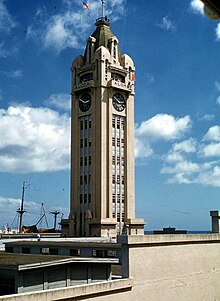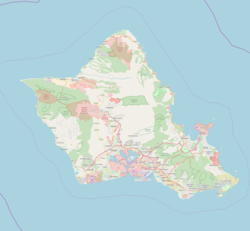
Honolulu is the capital and most populous city of the U.S. state of Hawaii, which is in the Pacific Ocean. An unincorporated city, it is the county seat of the consolidated City and County of Honolulu, situated along the southeast coast of the island of Oʻahu, and is the westernmost and southernmost major U.S. city. Honolulu is Hawaii's main gateway to the world. It is also a major hub for business, finance, hospitality, and military defense in both the state and Oceania. The city is characterized by a mix of various Asian, Western, and Pacific cultures, reflected in its diverse demography, cuisine, and traditions.

The Bernice Pauahi Bishop Museum, designated the Hawaiʻi State Museum of Natural and Cultural History, is a museum of history and science in the historic Kalihi district of Honolulu on the Hawaiian island of Oʻahu. Founded in 1889, it is the largest museum in Hawaiʻi and has the world's largest collection of Polynesian cultural artifacts and natural history specimens. Besides the comprehensive exhibits of Hawaiian cultural material, the museum's total holding of natural history specimens exceeds 24 million, of which the entomological collection alone represents more than 13.5 million specimens. The Index Herbariorum code assigned to Herbarium Pacificum of this museum is BISH and this abbreviation is used when citing housed herbarium specimens.
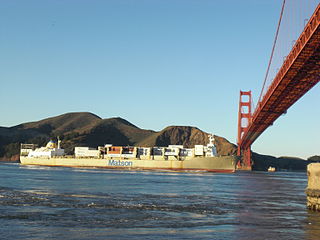
Matson, Inc., is an American shipping and navigation services company headquartered in Honolulu, Hawaii. Founded in 1882, Matson, Inc.'s subsidiary Matson Navigation Company provides ocean shipping services across the Pacific to Hawaii, Alaska, Guam, Micronesia, the South Pacific, China, and Japan.
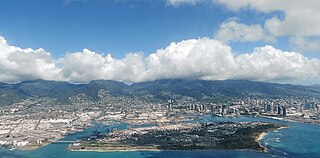
Honolulu Harbor, also called Kulolia and Ke Awa O Kou and the Port of Honolulu, is the principal seaport of Honolulu and the State of Hawaiʻi in the United States. From the harbor, the City & County of Honolulu was developed and urbanized, in an outward fashion, over the course of the modern history of the island of Oahu. It includes Matson, Inc. harbors on Sand Island.
The following is an alphabetical list of articles related to the U.S. state of Hawaii:
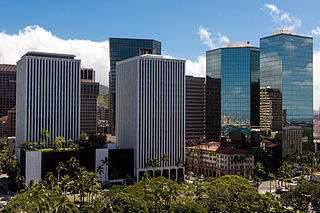
Downtown Honolulu is the current historic, economic, and governmental center of Honolulu, the capital and largest city of the U.S. state of Hawaii. It is bounded by Nuʻuanu Stream to the west, Ward Avenue to the east, Vineyard Boulevard to the north, and Honolulu Harbor to the south. Both modern and historic buildings and complexes are located in the area, with many of the latter declared National Historic Landmarks on the National Register of Historic Places.

Hawaiʻi Pacific University (HPU) is a private university in downtown Honolulu, Makapuʻu and Kāneʻohe, Hawaiʻi. Oceanic Institute of HPU, an aquaculture research facility, is located at Makapuʻu Point. HPU is also present on military installations on the island of Oʻahu.

Kakaʻako is a commercial and retail district of Honolulu, Hawaiʻi between Ala Moana near Waikīkī to the east and downtown Honolulu and Honolulu Harbor to the west. Kakaʻako is situated along the southern shores of the island of Oʻahu, Hawaiʻi.
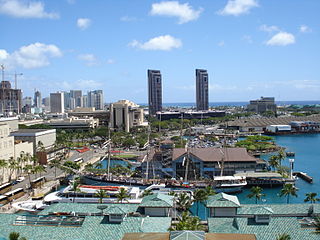
The Hawai`i Maritime Center was the principal maritime museum in the State of Hawai`i from 1988 until it closed in 2009. Located at Pier 7 of Honolulu Harbor east of Aloha Tower, the center was a campus of the Princess Bernice Pauahi Bishop Museum. The Hawai`i Maritime Center was built on what once was the private boathouse of King David Kalakaua and was home to the only four-masted, full-rigged ship in the world called the Falls of Clyde. The Falls of Clyde was built in 1878 for the oil industry and is a National Historic Landmark. Also docked at the Hawai`i Maritime Center was the voyaging canoe Hokule`a, a scientific research vessel of great importance to native Hawaiian culture.

Falls of Clyde is the last surviving iron-hulled, four-masted full-rigged ship, and the only remaining sail-driven oil tanker. Designated a U.S. National Historic Landmark in 1989, she is now a museum ship in Honolulu, but her condition has deteriorated. She is currently not open to the public. In September 2008, ownership was transferred to a new nonprofit organization, the Friends of Falls of Clyde. Efforts to raise $1.5 million to get the ship into drydock did not succeed. In November 2021 HDOT accepted a bid from Save Falls of Clyde – International (FOCI) to transport the ship to Scotland for restoration.

The Aloha Tower Marketplace is a waterfront shopping center in Honolulu, Hawaiʻi. Located at the Honolulu Harbor, the Aloha Tower Marketplace includes several national historic landmarks including the Aloha Tower, Falls of Clyde and Hawaiʻi Maritime Center.
Kamehameha Highway is one of the main highways serving suburban and rural O‘ahu in the U.S. state of Hawai‘i. Informally known as Kam Highway, it begins at Nimitz Highway near Pearl Harbor and Hickam Air Force Base in Honolulu, serves the island's older western suburbs, and turns north across the O‘ahu Central Valley to the North Shore. At the North Shore, Kamehameha Highway heads northeast around the northern tip of O‘ahu, then southeast to and just beyond Kāne‘ohe Bay on the windward coast. The road was named after King Kamehameha I.
The Hawai'i Pacific Health Great Aloha Run is a road race that takes place annually in Honolulu, Hawaii on the third weekend in February. It is a charity event that benefits Carole Kai Charities, a philanthropic fund run by Hawaii entertainer Carole Kai. Kai, Honolulu Marathon founder Jack Scaff, M.D., and publicist-journalist Buck Buchwach founded the race in 1985, and since its inception it has donated over $14 million to over 100 non-profit organizations in Hawaii.

The Port of San Francisco is a semi-independent organization that oversees the port facilities at San Francisco, California, United States. It is run by a five-member commission, appointed by the Mayor and approved by the Board of Supervisors. The Port is responsible for managing the larger waterfront area that extends from the anchorage of the Golden Gate Bridge, along the Marina district, all the way around the north and east shores of the city of San Francisco including Fisherman's Wharf and the Embarcadero, and southward to the city line just beyond Candlestick Point. In 1968, the State of California, via the California State Lands Commission for the State-operated San Francisco Port Authority, transferred its responsibilities for the Harbor of San Francisco waterfront to the City and County of San Francisco / San Francisco Harbor Commission through the Burton Act AB2649. All eligible State port authority employees had the option to become employees of the City and County of San Francisco to maintain consistent operation of the Port of San Francisco.

Kenosha Light is a lighthouse and keeper's house on Simmons Island north of the channel into Kenosha's harbor in Kenosha County, Wisconsin, USA.

The Copper Harbor Light is a lighthouse located in the harbor of Copper Harbor, Michigan USA on the Keweenaw Peninsula of Upper Michigan inside Fort Wilkins Historic State Park. It is a Michigan State Historic Site and listed on the National Register of Historic Places.

HST-2, formerly named USNS Puerto Rico and Alakai, is a vessel owned by the United States Navy Military Sealift Command. She was originally Hawaii Superferry's first high-speed ferry. The vessel was later chartered by Bay Ferries Limited to operate a ferry service between Maine and Yarmouth, Nova Scotia.

Hālawa station is a Skyline metro station in Hālawa, Hawaiʻi, serving Aloha Stadium, ʻAiea, Salt Lake, and Moanalua. The station is located alongside Kamehameha Highway above its intersection with Salt Lake Boulevard. It serves as the eastern terminus of the current rail system and opened on June 30, 2023. The station has a 590-space park and ride lot.

Naval Base Hawaii was a number of United States Navy bases in the Territory of Hawaii during World War II. At the start of the war, much of the Hawaiian Islands was converted from tourism to a United States Armed Forces base. With the loss of US Naval Base Philippines in Philippines campaign of 1941 and 1942, Hawaii became the US Navy's main base for the early part of the island-hopping Pacific War against Empire of Japan. Naval Station Pearl Harbor was founded in 1899 with the annexation of Hawaii.

